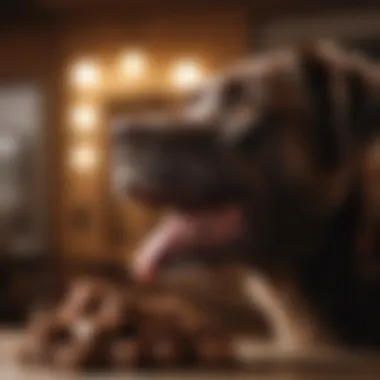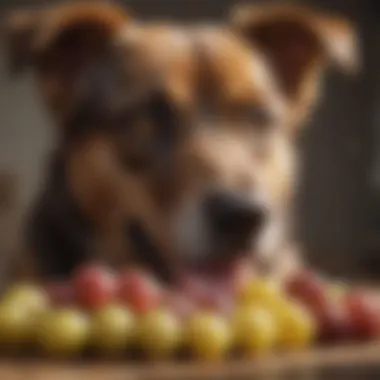Foods That Are Harmful to Dogs' Health


Intro
Understanding what a dog can and cannot eat is crucial for any dog owner. Many human foods are not just unpalatable for dogs, but they can also pose serious health risks. The relationship between dogs and their food is more than just a matter of taste; it dives deep into how certain ingredients interact with a dog’s unique physiology. Dogs metabolize foods different from humans, which means that a treat that may seem harmless to us could very well be toxic to them. This article aims to shed light on those foods that every dog owner should steer clear of, ensuring our furry companions stay happy and healthy.
Foods That Are Toxic to Dogs
When it comes to safeguarding your dog’s health, knowledge is power. Here are some common foods that are notorious for causing harm:
- Chocolate
Chocolate contains theobromine, which is toxic to dogs. Even small amounts can lead to serious health issues, including heart problems or seizures. - Grapes and Raisins
These innocent snacks can cause kidney failure in dogs. The exact substance responsible is still unknown, making it more dangerous. - Onions and Garlic
Both of these can damage a dog's red blood cells, leading to anemia. It’s not just raw but also cooked forms that are harmful. - Avocado
This food contains persin, which can be dangerous for dogs, especially in large quantities. - Macadamia Nuts
Just a handful can lead to weakness, tremors, or hyperthermia in dogs.
Signs of Food Poisoning
It’s critical to remain vigilant. Here are signs that a dog may have ingested something harmful:
- Vomiting
- Diarrhea
- Lethargy
- Excessive drooling
- Abdominal pain
In cases of suspicion, contacting a veterinarian is top priority.
Safe Alternatives for Dogs
To ensure your dog leads a happy and healthy life, here are some safe foods you can substitute:
- Carrots
Crunchy and sweet, they make an excellent low-calorie snack. - Apples
They are a good source of vitamins A and C. Make sure to remove the seeds! - Peanut Butter
An excellent treat packed with protein — just ensure it's free of xylitol, which is toxic to dogs.
Ending
By steering clear from harmful foods and opting for safe alternatives, dog owners can provide a nourishing diet that supports health and happiness. Being aware of what's on your dog's plate is not just about taste; it's about their well-being.
Prologue to Canine Nutrition
When it comes to your dog's well-being, understanding their nutritional needs is fundamental. Just like humans, dogs require a balanced diet to thrive. However, it's not just about satisfying hunger; it's about fueling your furry friend with the right nutrients to promote health, energy, and longevity. This is where the topic of canine nutrition becomes significant. Through this article, we want to delve into what dogs should steer clear of in terms of food—particularly human foods that can end up doing more harm than good.
Understanding Dogs' Dietary Needs
Dogs, while family-oriented and often spoiled with leftover bites from our plates, have very unique dietary requirements. Unlike their human companions, who can munch down a wide variety of foods, dogs have specific nutritional profiles they need to maintain their health. For example, while protein is a cornerstone of canine nutrition, not all protein sources are suitable. Foods like chicken, fish, and lamb provide essential amino acids, whereas certain meats like raw pork can carry risks such as parasites.
Moreover, carbohydrates can play a role, too. Dogs can digest certain grains and vegetables, but they don’t need them in excess. A good rule of thumb is to ensure that about 40% of their meal consists of high-quality protein, with balanced portions of fats, vitamins, and minerals. The needs may vary based on factors such as age, size, and breed, so consulting with a veterinarian is advisable to tailor a diet fit for your dog's individual requirements.
The Role of Human Foods
While some human foods can be safe or even beneficial for dogs, many pose significant risks. It’s critical for dog owners to distinguish between safe treats and harmful substances. For instance, a small slice of apple is usually a safe snack, providing vitamins A and C, while chocolate or raisins might just land your furry friend in serious trouble.
Furthermore, there’s a misconception that sharing food with dogs is a sign of affection. Though this may be true in certain contexts, it can often lead to grave mistakes in dietary choices. Dogs lack the digestive enzymes required to process many foods that humans can consume without a second thought, resulting in a potential range of health issues—from gastrointestinal distress to severe toxicity.
"A loving gesture such as sharing food can turn dangerous if one isn't aware of what their dog can or cannot eat."
In understanding these nuances, pet owners can cultivate healthier habits not only for their pets but for themselves as well, as they learn to keep a watchful eye on the types of human food being shared. Awareness is the first step in safeguarding canine health and ensuring a long, happy life.
Common Foods Toxic to Dogs
Understanding what can harm our furry friends is crucial for every dog owner. The topic of common foods toxic to dogs serves not just as a warning but as an imperative guideline to ensure their well-being. While dogs may seem robust, they can be surprisingly sensitive to many human foods, and some can even lead to life-threatening conditions.
It’s essential to disseminate knowledge about potential threats lurking in food items often found in our homes. By enlightening dog owners on these dangers, we can prevent severe health issues, enhance the quality of life for our pets, and foster a deeper understanding of canine nutrition.
Chocolate
Chocolate is not just a delicious treat for humans; it can be a lethal indulgence for dogs. A key ingredient in chocolate is theobromine, which is metabolized in canines at a much slower rate than in humans.
How Theobromine Affects Dogs


The main concern with theobromine is its stimulant properties. When dogs consume chocolate, the theobromine can quickly build up in their systems, leading to increased heart rates, abnormal heart rhythms, and in severe cases, seizures. The severity of these symptoms can vary widely depending on the dog’s size, the type of chocolate, and the quantity consumed.
It’s important to point out that dark chocolate and baking chocolate contain much higher levels of theobromine compared to milk chocolate. An informed pet owner should keep these treats securely out of reach.
Signs of Chocolate Poisoning
Being able to recognize the signs of chocolate poisoning could be a life-saver. Common symptoms include vomiting, diarrhea, rapid breathing, and elevated heart rate. If you spot any of these signs, it’s crucial to contact a veterinarian without delay. Early intervention can often make the difference between a quick recovery and severe complications.
Onions and Garlic
Onions and garlic might add flavor to our meals, but they are deadly to dogs. They belong to the Allium family, and they contain compounds that can cause oxidative damage to red blood cells in dogs.
Mechanisms of Hemolytic Anemia
The primary risk from onions and garlic is hemolytic anemia. The compounds present in these foods can destroy red blood cells. This destruction leads to a lack of oxygen transport within the body, causing lethargy and weakness. Regardless of whether these foods are raw or cooked, their effects remain harmful. Even small amounts can accumulate and become toxic over time.
Long-Term Effects on Canine Health
Long-term exposure to onions and garlic can lead to lasting health consequences for dogs. Some breeds, such as Shiba Inus and Akitas, may be more susceptible to these toxic effects. It’s crucial for pet owners to be vigilant about their dogs' diets. A consistent focus on safe feeding helps prevent these underlying health risks.
Grapes and Raisins
Grapes, along with their dried counterparts, raisins, pose another danger. While the exact toxin remains a mystery, it's clear that even a small quantity can lead to acute kidney injury in some dogs.
Understanding Acute Kidney Injury
Acute kidney injury is a serious condition that can result from ingesting grapes or raisins. It can lead to sudden and irreversible damage to kidney functions, making it difficult for the body to filter waste. Notably, not all dogs react to grapes and raisins in the same way; some can ingest them without immediate effects while others can fall ill after a modest serving.
Recognizing Early Symptoms
Early signs of kidney injury can include vomiting, lethargy, and decreased appetite. A vigilant pet owner should act quickly if they suspect ingestion, since early detection is key for effective treatment. Quick intervention can significantly impact long-term outcomes for affected dogs.
Avocado
Avocado is enjoyed by many for its numerous health benefits, but it is one food that should never find its way into a dog's bowl.
Persin Toxicity Explained
The toxic compound in avocado is called persin. It can cause gastrointestinal upset in dogs, leading to vomiting and diarrhea. While some dogs might tolerate small amounts, it’s best to avoid any avocado entirely to prevent any potential health issues.
Safe Portions and Alternative Foods
As with other human foods toxic to dogs, understanding safe limits is key. However, it’s generally safer to offer alternative foods rich in nutrients, like blueberries or carrots, that pose no risks and provide health benefits instead.
Macadamia Nuts
Macadamia nuts may seem harmless, but they can spark serious neurotoxic effects in dogs. Even a handful can lead to major health issues.
Neurotoxic Effects on Dogs
The exact mechanism of toxicity is not completely understood, but it leads to muscle tremors, weakness, and in severe cases, significant neurological issues. It's paramount to keep these nuts out of your dog's reach completely.
Symptoms to Watch For
Symptoms of macadamia nut toxicity can include fever, vomiting, and trembling. Dog owners need to act promptly. If ingestion is suspected, immediate veterinary consultation is imperative.
Alcohol
Many might be surprised to find out that alcohol can be extremely harmful to dogs. Just a small amount can have serious implications.
Understanding Ethanol Poisoning


Ethanol, the intoxicating component in alcoholic beverages, affects dogs similarly to humans, though dogs are much more sensitive to its effects. Symptoms can range from vomiting to severe central nervous system depression. Alcohol can quickly lead to life-threatening conditions, so being aware of this is incredibly important for any pet owner.
Potential Outcomes
The potential effects of alcohol consumption can lead to significant danger, including respiratory failure or even death in extreme cases. Understanding this risk is crucial to keep our furry friends safe and healthy.
Xylitol
Xylitol, a sugar substitute often found in sugar-free products, is highly toxic to dogs. Its ingestion can instantly trigger a dangerous series of events.
Mechanism of Insulin Release
When dogs consume xylitol, it leads to a rapid release of insulin, causing blood sugar levels to plummet. This can result in acute hypoglycemia, leading to seizures and loss of consciousness. Being cautious about food labels that contain xylitol is vital.
Potential for Liver Damage
In higher doses, xylitol can cause severe liver failure in dogs. Recognizing exactly what foods might contain this ingredient can save lives. Always check labels and stay informed about this hidden danger.
Foods That May Cause Digestive Issues
Understanding what foods can trigger digestive problems in dogs is crucial for every pet owner. Dogs have different digestive systems than humans, which means certain foods can cause them discomfort or worse. When a dog’s stomach isn’t happy, it can lead to vomiting, diarrhea, or even more severe health issues down the line. By familiarizing ourselves with these problematic foods, we can take proactive measures to ensure our furry friends stay healthy and feel their best.
Dairy Products
Lactose Intolerance in Dogs
Lactose intolerance is a key aspect when considering dairy products for dogs. Just like some humans, many dogs lack the enzyme lactase, which is necessary for breaking down lactose found in milk and other dairy items. This can lead to uncomfortable digestive upset. It's a significant factor to consider in our article because it underscores that some foods, while nutritious for humans, may not suit dogs. Some breeds, like Australian Shepherds and Dachshunds, are particularly prone to this issue.
One unique feature of lactose intolerance is that not all dairy products are created equal. For instance, hard cheeses often have less lactose than milk does, which might make them a better option for a dog that can tolerate dairy to some extent. However, while these small cheese bits might be an occasional treat, a steady diet of dairy can result in adverse health effects.
Identifying Symptoms
Recognizing the signs of lactose intolerance in dogs can be challenging, as they can appear similar to other digestive issues. Common symptoms may include gas, bloating, diarrhea, or soft stools. Pay attention to your dog's reactions after consuming dairy; if there are recurring symptoms, it's a red flag. Understanding these symptoms is crucial as it helps in preventing potential discomfort for our pets.
Many dog owners may not realize that their dogs are affected by lactose intolerance until they notice an ongoing issue. If spotting issues early, owners can swiftly make dietary adjustments, helping to avoid further complications.
Spicy Foods
Potential Irritation to the Digestive Tract
Spicy foods are a definite no-go for dogs. These foods can cause irritation to their sensitive digestive tract. What might be a culinary delight for humans can become a cause of distress for dogs. Spices like chili powder can lead to stomach pain or discomfort, leading to digestive upset. It's vital to note that dogs' digestive systems are not equipped to handle the heat that humans might enjoy.
Moreover, some spicy foods can contribute to inflammation in the digestive tract if consumed regularly. Keeping spicy items off their menu helps ensure they avoid unnecessary suffering and complications.
Long-Term Implications
The long-term implications of feeding dogs spicy foods can be severe. Over time, continuous irritation may lead to serious health issues like gastritis or even ulcers. This becomes a significant point of concern for dog owners, as these conditions can result in costly vet bills and serious health risks for pets.
It's worth mentioning that dogs can’t communicate how they feel the way humans do, so owners must be their voice. By understanding the impact of spicy foods, owners can better protect their pets from adverse health effects.
Fatty Foods
Risk of Pancreatitis
Fatty foods can pose a serious risk to dogs, particularly the development of pancreatitis. This inflammation of the pancreas can result from consuming too much fat in one sitting. Symptoms may include vomiting, abdominal pain, and lethargy, which can be alarming for any dog owner.
Additionally, some dogs are more predisposed to pancreatitis, such as those who are overweight or those contained in certain breeds. Recognizing this risk is an important consideration, as it illustrates how harmful human food can be in moderation, or lack thereof, leading to potential health disasters.
Signs of Digestive Distress


Signs of digestive distress in dogs should never be brushed off. Look for symptoms like changes in appetite, prolonged vomiting, or unusual behaviors like hiding. Recognizing these early can prevent an escalation from simple discomfort to something more severe, such as needing hospitalization.
It’s essential for dog owners to monitor their pets closely, especially after rich, fatty treat days or family gathering mealtime scraps. Knowing what to look for means being better prepared to act in the best interests of their dog’s health.
Safe Alternatives for Dogs
When it comes to feeding our furry friends, knowing what they shouldn't eat is just half the battle. While it’s crucial to steer clear of toxic and harmful foods, it’s equally important to explore the safe alternatives that can be included in their diets. Incorporating safe alternatives creates a well-rounded nutrition plan that supports overall health while also enhancing the joy of feeding them. Dogs, much like humans, benefit from variety and taste, so finding healthy replacements can keep them happy and healthy.
High-Quality Commercial Dog Food
Opting for high-quality commercial dog food is essential for ensuring that your canine companion receives all the essential nutrients. Unlike generic options, premium brands often undergo rigorous testing and adhere to strict standards for ingredient quality. They tend to be formulated by veterinarians and pet nutrition experts, ensuring they meet the specific needs based on your dog's breed, age, and health condition.
When looking for a good commercial dog food, it is advisable to check for high protein content, the inclusion of whole ingredients, and a lack of fillers. Ingredients like corn or by-products should be avoided. A well-balanced commercial diet can alleviate the stress of wondering whether your dog is getting all the nutrients they need, especially when transitioning away from human foods that can cause harm.
Homemade Treats
Creating homemade treats for your dog can be both fun and meaningful. These treats allow you control over the ingredients, allowing you to avoid the unhealthy fillers and preservatives found in many commercial options.
Simple Recipes for Healthy Snacks
Homemade recipes such as pumpkin biscuits or chicken jerky stand out as easy-to-make options that your pup will love. For instance, a basic pumpkin biscuit can be made by mixing:
- 1 cup of whole wheat flour
- 1/2 cup of canned pumpkin
- 1/4 cup of peanut butter
- 1 egg
Simply mix ingredients together, roll out the dough, cut it into shapes, and bake at 350°F for about 20 minutes. This not only ensures that the ingredients are safe, but it becomes a bonding activity as well. Your dog will start to associate these home-cooked goodies with quality time spent together.
Ingredients to Avoid
Even in homemade treats, awareness of harmful ingredients is crucial. Certain ingredients, even those that seem harmless to humans, can be detrimental to dogs. For example, avoid:
- Chocolate
- Xylitol
- Onions
- Garlic
These should never be in any home-prepared meals or snacks. Being vigilant about what goes into your dog’s treats helps in fostering a safe and healthy feeding regimen, ensuring that all moments shared are joyful and worry-free.
Fruits and Vegetables Safe for Dogs
Incorporating fruits and vegetables into your dog’s diet can provide a wonderful variety that benefits their health. Many fruits are rich in vitamins and antioxidants which are vital for maintaining a robust immune system.
List of Beneficial Options
Not all fruits and vegetables make the cut though. Some that are typically safe include:
- Carrots
- Blueberries
- Sweet potatoes
- Apples (with seeds and core removed)
Providing these as occasional treats can boost their fiber intake and enhance their hydration—especially the water-based fruits. These options are not only safe but also delicious for dogs, making them a win-win for pet owners looking to diversify their dogs’ diets.
How to Incorporate Them
Incorporating fruits and vegetables can be as simple as mixing small portions into their regular meals, or serving them fresh as a snack. For example, you could mix a few blueberries into their morning kibble or offer carrot sticks as a crunchy alternative to store-bought dog biscuits. It's all about making it fun while ensuring they still enjoy the health benefits.
The End
Understanding which foods are harmful to dogs is crucial for any pet owner. The implications of improper feeding extend far beyond simple digestive discomfort; they can lead to long-term health issues and even life-threatening conditions. This article underscores the fundamental idea that providing a balanced, safe diet is not merely a task—it's a responsibility that every dog owner must embrace. When we talk about the importance of proper diet, it reflects not just dietary guidelines but a holistic approach to dog care.
The Importance of Proper Diet
A nutritious diet shapes a dog's health, mood, and behavior. Many pet owners might not realize that commercial dog foods, while formulated to meet nutritional standards, can sometimes overlook the unique dietary needs of dogs. For instance, certain breeds can be sensitive to specific ingredients that are otherwise harmless to others. By being knowledgeable about what is safe and unsafe, you empower yourself to make decisions that can prevent health complications.
When dogs ingest toxic foods like chocolate or grapes, the immediate consequences might be vomiting or diarrhea. However, these symptoms can usher in much more severe repercussions, including organ failure or chronic conditions. Thus, the saying goes: "An ounce of prevention is worth a pound of cure." Keeping your canine companion away from harmful substances isn’t just good practice; it’s a form of respect towards their wellbeing.
Ongoing Research in Canine Nutrition
Nutrition, like many sciences, is always evolving. Ongoing research continuously sheds light on the complex interactions between certain foods and canine health. This is particularly vital when it comes to understanding the nuances of non-traditional diets, such as raw or grain-free options. Researchers are investigating how ingredients interact with a dog’s metabolism and immune system, challenging existing guidelines to optimize dietary recommendations.
New studies are emerging regularly, often exploring how specific nutrients can reduce the risk of diseases like obesity and diabetes, which are increasingly common in pets. Staying updated on these findings helps pet owners stay informed—allowing them to make educated dietary choices. Importantly, consulting with veterinarians who are in tune with the latest research can provide personalized dietary advice tailored to the specific needs of your dog.
In summary, a deep dive into canine nutrition reveals that it is a field rich with possibilities. By being aware of the potential dangers of human foods, the importance of a balanced diet, and the constantly shifting landscape of nutritional research, you can be proactive in safeguarding your dog's health.







